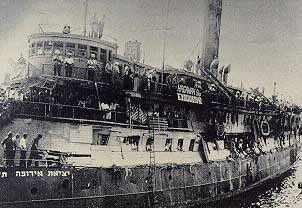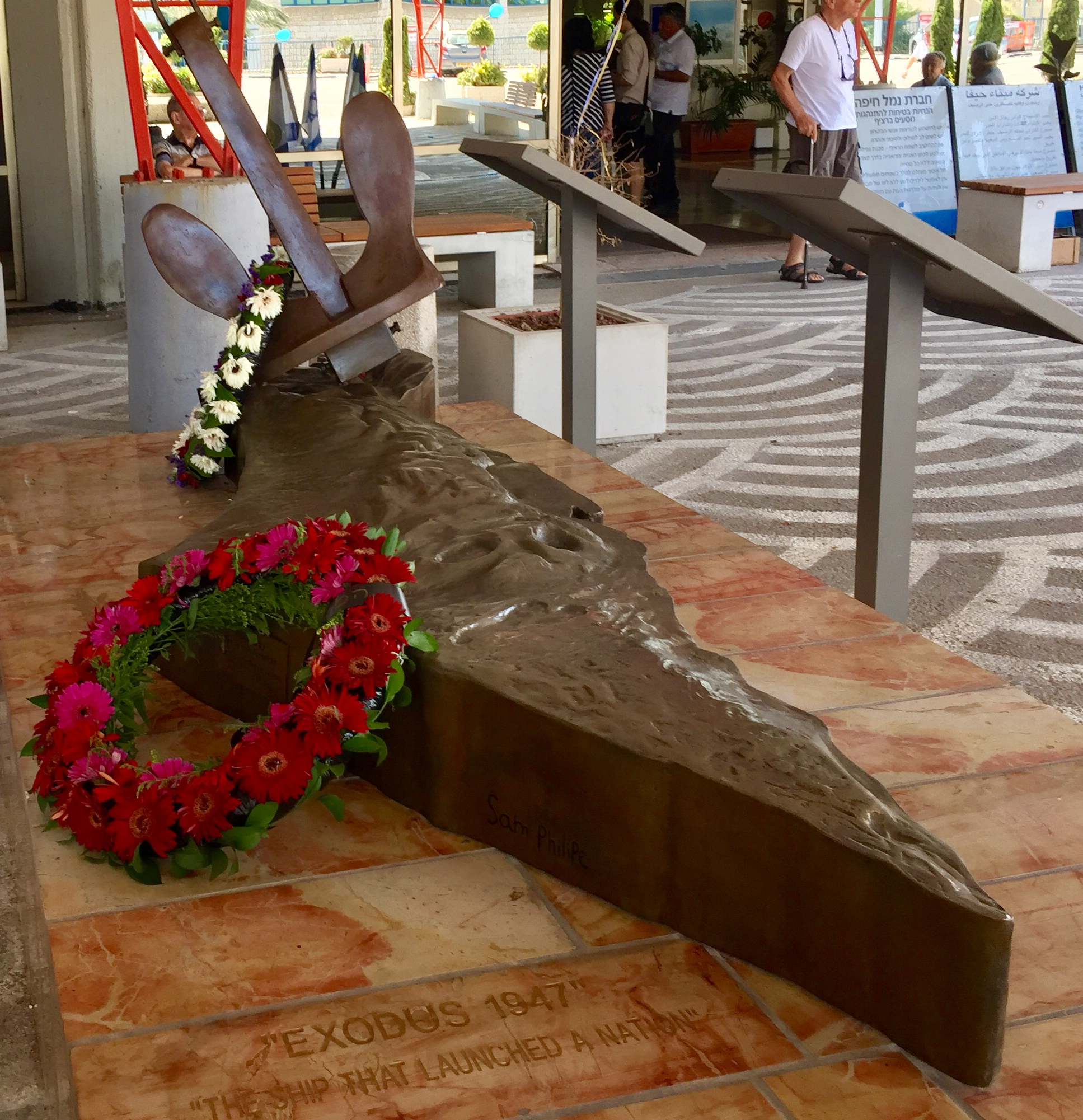Immigration to Israel: "Exodus 1947" Illegal Immigration Ship
(July 1947)
|
|
The ship, known as the President Warfield, was purchased secretly in Baltimore by Haganah operatives in 1946 for $40,000. It had been used for pleasure cruises by the Baltimore Steam Packet Company from 1928 until 1942 before being requisitioned by the U.S. Navy for operations in World War II. After the war, it was sold for scrap.
The Haganah, which had been using smaller ships for their clandestine Jewish immigration, decided it needed a larger ship to start moving thousands of refugees. The ship was 330 feet long with a capacity of roughly 500 passengers. It was renamed the Exodus 1947 at the suggestion of Moshe Sneh, who at the time headed illegal immigration for the Jewish Agency.
The initial crew of more than 40 men consisted mostly of American Jews with no sailing experience in boarded the ship in Baltimore. They were later joined by members of the Haganah and Palmach commanded by Aliya Bet veteran Yossi Harel. Yitzhak “Ike” Aronovitz, a 23-year-old sailor, originally from Danzig, was the captain.
The Haganah retrofitted the ship to accommodate more than 4,000 people, added defensive measures, such as netting, fencing and pipes for oiling the deck to slow down boarding soldiers, and loaded it with provisions for a seven-day voyage from France to Palestine.
The Haganah also brought onboard Rev. John Stanley Grauel, a Methodist minister who was sympathetic to the Zionist cause, to be a witness to the voyage. According to a Baltimore Jewish Times report from July 25, 1947:
The ship sailed from the port of Sète, near Marseilles, on July 11, 1947, with 4,515 immigrants, including 655 children, on board. Several babies were born during the week-long journey. One woman, Paula Abramowitz, died in childbirth. Her infant son died a few weeks later, in Haifa.
According to Israeli historian Aviva Halamish, unlike other illegal immigrant ships, the Exodus was never meant to sneak into Palestine, but rather “to burst openly through the blockade, by dodging and swiftly nipping through, beaching herself on a sand bank and letting off her cargo of immigrants at the beach.”
As soon as it left the territorial waters of France, British destroyers accompanied it. On July 18, near the coast of Palestine, but outside territorial waters, the British rammed the ship and boarded it, while the immigrants put up a desperate defense.
Arie Itamar was only eight years old when he boarded the Exodus. In his 2007 book about his experiences, “Misty Mists,” Itamar recalled the British boarding the ship:
During the fighting that ensued after the British boarded, American Mahal volunteer Bill Bernstein was clubbed to death in the wheelhouse. Two immigrant passengers died of gunshot wounds and dozens were wounded. To avoid further bloodshed, ship commander Harel and captain Aronovitz surrendered the ship and the British towed it to Haifa.
Heartbreakingly close to their homeland, the immigrants were forced onto three deportation ships, the Runnymede Park, Ocean Vigour, and Empire Rival on July 19. Instead of sending them to Cyprus, where other illegal immigrants were imprisoned, British Foreign Minister Ernest Bevin decided to make an example of the Exodus to try to discourage future attempts to reach Palestine and ordered the refugees to be sent back to France.
At Port-de-Bouc, in southern France, the would-be immigrants remained in the ships’ holds for 24 days during a heat wave, refusing to disembark despite the shortage of food, the crowding, and the abominable sanitary conditions. The French government refused to force them off the boat.
Ruth Gruber was the only American journalist allowed onto the Runnymede Park, which had 1,500 of the refugees from the Exodus. “When the refugees learned that they had an American Jew on board,” she said, “they raised a banner. They had painted the swastika on top of the Union Jack.”
After three weeks of the standoff, the British decided to return the would-be immigrants to Germany, and on August 22 the ship left for the port of Hamburg, then in the British occupation zone. The immigrants were forcibly taken off and transported to two camps, Poppendorf and Am Stau, near Lubeck.
The sight of Jewish survivors of the Holocaust being forcibly relocated to Germany caused an international uproar. World public opinion was outraged and the British changed their policy. Illegal immigrants subsequently were not sent back to Europe; they were instead transported to detention camps in Cyprus.
The British knew their actions would be unpopular. John Coulson, a diplomat at the British Embassy in Paris, cabled the Foreign Office in London in August 1947: “You will realize that an announcement of decision to send immigrants back to Germany will produce violent hostile outburst in the press. ... Our opponents in France, and I dare say in other countries, have made great play with the fact that these immigrants were being kept behind barbed wire, in concentration camps and guarded by Germans.”
On September 29, 1947, the Irgun and Lehi blew up Central Police headquarters in Haifa in retaliation for the British deportation of the Exodus passengers. Ten people were killed and 54 injured.
The deportees were moved in November 1947 to Sengwarden near Wilhelmshaven and Emden. Of the 4,500 would-be immigrants to Palestine, there were only 1,800 remaining in the two Exodus camps by April 1948. Many of the former passengers retried to reach Palestine and most succeeded by the time Israel declared independence on May 14, 1948. Others ended up in detention in Cyprus. All the detainees of the Cyprus internment camps were transferred to Israel when Britain formally recognized the State of Israel in January 1949.
The United Nations Special Committee on Palestine was in Palestine conducting its investigation to determine how to resolve the conflicting demands of the Zionists and Arabs. The treatment of the Exodus refugees apparently influenced some members to advocate a solution that would allow Jews to immigrate freely to a state of their own.
The U.S. Holocaust Memorial Museum noted the significance of the Exodus saga:
The captain of the Exodus, Ike Aronovitz, later founded his own shipping company. He died in Israel on December 23, 2009, aged 86. Yossi Harel, the commander, went on to serve in Israeli intelligence and became a successful businessman. He died in Tel Aviv on May 1, 2008, aged 90.
On July 18, the 70th anniversary of the British attack, a memorial to the Exodus was unveiled in the International Cruise Ship Terminal in Haifa. Among the guests were Yossi Harel’s daughter and Ike Aronovitz’s family.
|
Exodus 1947 Memorial Haifa |
To view pictures of the Exodus 1947, Click Here
Sources: Israel Foreign Ministry;
Exodus 1947 (1996);
Exodus 1947 - The Ship That Launched a Nation (now streaming free for Amazon Prime customers;
Susan Ingram, “The Ship That Launched a Nation,” Baltimore Jewish Times, (July 26, 2017);
“SS Exodus,” Wikipedia;
“Ruth Gruber,” Wikipedia;
“Exodus 1947,” USHMM;
“Ike Aronowicz,” Wikipedia;
Douglas Martin, “Yossi Harel, Who, Defying British, Brought Jews to Palestine, Is Dead at 90,” New York Times, (May 1, 2008);
Ruth Gruber, “Ruth Gruber: Witness for the World,” American Photo, (September 28, 2012).
Memorial photo courtesy of Jerry Klinger.




